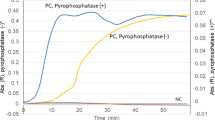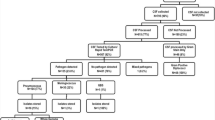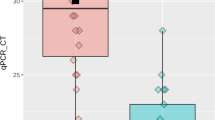Abstract
The surveillance of serotypes causing invasive pneumococcal disease (IPD) provides further insight into the pathogenesis of pneumococcal disease and is important in order to track vaccine impact. Although the Quellung reaction has been accepted as the standard method for serotyping, prior antibiotic use causes a gap in studies based on bacterial culture. A total of 31 cerebrospinal fluid (CSF) samples found to be positive for Streptococcus pneumoniae by polymerase chain reaction (PCR) targeting the ply gene during an active surveillance were tested in a Bio-Plex multiplex antigen detection assay capable of detecting 14 serotypes/groups (1, 3, 4, 5, 6A, 6B, 7F/A, 8, 9V, 14, 18, 19A, 19F, and 23F). Twenty-seven CSF samples could be serotyped. The most common serotypes were serotypes 5 (n = 7), 19F (n = 5), 1 (n = 3), and 23F (n = 3). Theoretical coverage rates by the heptavalent (PCV7), 10-valent (PCV10), and 13-valent (PCV13) pneumococcal conjugate vaccines for bacterial meningitis were 48.1, 85.2, and 92.3%, respectively, for all age groups and 71.4, 85.7, and 100.0%, respectively, for those under 2 years of age. We propose that antigen detection assay used in conjunction with a PCR assay can be effectively applied in CSF samples to detect the pneumococcal serotypes, especially when the patient may have already been treated and, therefore, the cultures would be negative.


Similar content being viewed by others
Reference
Melegaro A, Edmunds WJ, Pebody R et al (2006) The current burden of pneumococcal disease in England and Wales. J Infect 52:37–48
Ceyhan M, Yildirim I, Balmer P et al (2008) A prospective study of etiology of childhood acute bacterial meningitis, Turkey. Emerg Infect Dis 14:1089–1096
Hausdorff WP, Bryant J, Paradiso PR et al (2000) Which pneumococcal serogroups cause the most invasive disease: implications for conjugate vaccine formulation and use, part I. Clin Infect Dis 30:100–121
Finland M, Barnes MW (1977) Changes in occurrence of capsular serotypes of Streptococcus pneumoniae at Boston City Hospital during selected years between 1935 and 1974. J Clin Microbiol 5:154–166
Hausdorff WP, Siber G, Paradiso PR (2001) Geographical differences in invasive pneumococcal disease rates and serotype frequency in young children. Lancet 357:950–952
Hausdorff WP, Feikin DR, Klugman KP (2005) Epidemiological differences among pneumococcal serotypes. Lancet Infect Dis 5:83–93
Tzanakaki G, Tsopanomichalou M, Kesanopoulos K et al (2005) Simultaneous single-tube PCR assay for the detection of Neisseria meningitidis, Haemophilus influenzae type b and Streptococcus pneumoniae. Clin Microbiol Infect 11:386–390
Leeming JP, Cartwright K, Morris R et al (2005) Diagnosis of invasive pneumococcal infection by serotype-specific urinary antigen detection. J Clin Microbiol 43:4972–4976
Sheppard C, Brown K, Harrison TG, et al (2006) A multiplex immunoassay for serotype-specific pneumococcal antigen detection directly from clinical specimens. In: Proceedings of the 5th International Symposium on Pneumococci and Pneumococcal Diseases, Alice Springs, Australia, April 2006, p 116
Farrington M, Rubenstein D (1991) Antigen detection in pneumococcal pneumonia. J Infect 23:109–116
Lenthe-Eboa S, Brighouse G, Auckenthaler R et al (1987) Comparison of immunological methods for diagnosis of pneumococcal pneumonia in biological fluids. Eur J Clin Microbiol 6:28–34
Murdoch DR, Anderson TP, Beynon KA et al (2003) Evaluation of a PCR assay for detection of Streptococcus pneumoniae in respiratory and nonrespiratory samples from adults with community-acquired pneumonia. J Clin Microbiol 41:63–66
Murdoch DR, Laing RT, Cook JM (2003) The NOW S. pneumoniae urinary antigen test positivity rate 6 weeks after pneumonia onset and among patients with COPD. Clin Infect Dis 37:153–154
Murdoch DR (2003) Nucleic acid amplification tests for the diagnosis of pneumonia. Clin Infect Dis 36:1162–1170
Findlow H, Laher G, Balmer P et al (2009) Competitive inhibition flow analysis assay for the non-culture-based detection and serotyping of pneumococcal capsular polysaccharide. Clin Vaccine Immunol 16:222–229
Lexau CA, Lynfield R, Danila R et al (2005) Changing epidemiology of invasive pneumococcal disease among older adults in the era of pediatric pneumococcal conjugate vaccine. JAMA 294:2043–2051
Huang SS, Platt R, Rifas-Shiman SL et al (2005) Post-PCV7 changes in colonizing pneumococcal serotypes in 16 Massachusetts communities, 2001 and 2004. Pediatrics 116:e408–e413
Pelton SI (2008) Replacement pneumococcal disease in perspective. Clin Infect Dis 46:1353–1355
Byington CL, Samore MH, Stoddard GJ et al (2005) Temporal trends of invasive disease due to Streptococcus pneumoniae among children in the intermountain west: emergence of nonvaccine serogroups. Clin Infect Dis 41:21–29
Hanage WP, Huang SS, Lipsitch M et al (2007) Diversity and antibiotic resistance among nonvaccine serotypes of Streptococcus pneumoniae carriage isolates in the post-heptavalent conjugate vaccine era. J Infect Dis 195:347–352
Huang SS, Finkelstein JA, Lipsitch M (2005) Modeling community- and individual-level effects of child-care center attendance on pneumococcal carriage. Clin Infect Dis 40:1215–1222
Porat N, Barkai G, Jacobs MR et al (2004) Four antibiotic-resistant Streptococcus pneumoniae clones unrelated to the pneumococcal conjugate vaccine serotypes, including 2 new serotypes, causing acute otitis media in southern Israel. J Infect Dis 189:385–392
Aslan G, Emekdas G, Bayer M et al (2007) Serotype distribution of Streptococcus pneumoniae strains in the nasopharynx of healthy Turkish children. Indian J Med Res 125:582–587
Ozdemir B, Beyazova U, Camurdan AD et al (2008) Nasopharyngeal carriage of Streptococcus pneumoniae in healthy Turkish infants. J Infect 56:332–339
Bogaert D, De Groot R, Hermans PW (2004) Streptococcus pneumoniae colonisation: the key to pneumococcal disease. Lancet Infect Dis 4:144–154
Yalçin I, Gürler N, Alhan E et al (2006) Serotype distribution and antibiotic susceptibility of invasive Streptococcus pneumoniae disease isolates from children in Turkey, 2001–2004. Eur J Pediatr 165:654–657
Firat M, Ersoy Y, Eşel D et al (2006) Antimicrobial susceptibility and serotype distribution of pneumococci strains isolated from meningitis patients. Mikrobiyol Bul 40:169–177
Malfroot A, Verhaegen J, Dubru JM et al (2004) A cross-sectional survey of the prevalence of Streptococcus pneumoniae nasopharyngeal carriage in Belgian infants attending day care centres. Clin Microbiol Infect 10:797–803
Soewignjo S, Gessner BD, Sutanto A et al (2001) Streptococcus pneumoniae nasopharyngeal carriage prevalence, serotype distribution, and resistance patterns among children on Lombok Island, Indonesia. Clin Infect Dis 32:1039–1043
Author information
Authors and Affiliations
Corresponding author
Rights and permissions
About this article
Cite this article
Ceyhan, M., Yildirim, I., Sheppard, C.L. et al. Pneumococcal serotypes causing pediatric meningitis in Turkey: application of a new technology in the investigation of cases negative by conventional culture. Eur J Clin Microbiol Infect Dis 29, 289–293 (2010). https://doi.org/10.1007/s10096-009-0853-y
Received:
Accepted:
Published:
Issue Date:
DOI: https://doi.org/10.1007/s10096-009-0853-y




